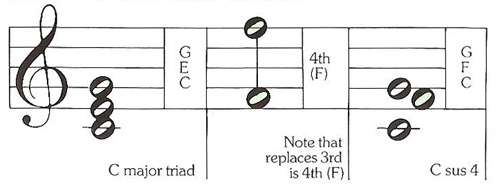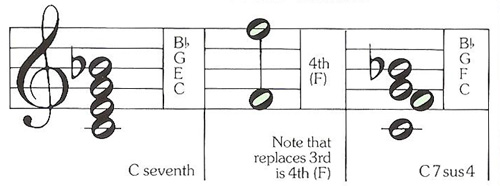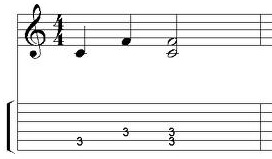fourth

How a suspended fourth chord is formed.

How a seventh suspended fourth chord is formed.
A 'fourth' may refer to any of the following:
Interval of a fourth
An interval of a perfect fourth consists of two whole tones and one semitone (i.e., five semitones or half-steps). For example, in the scale of C major (C D E F G A B C), F is a perfect fourth above the root note C. F is said to be the subdominant note in the scale of C major. The term 'perfect' refers to the fact that this interval (like the perfect fifth) is neither major nor minor. The perfect fourth occurs most commonly between the fifth and upper root of all major and minor triads and their extensions.
 |
| (top) The notes C and F, a perfect fourth apart,
played separately as quarter-notes and together harmonically as a
half-note. (bottom) These notes, shown in tab form, as played on the
fourth and fifth strings of a guitar.
|
When a perfect fourth is represented on the stave, if the root is on a line then the fourth note will lie between lines, and if the root is between lines the fourth note will lie on a line. Between the notes are one line and a half space. The intervals between the strings on a guitar in standard tuning are all fourths, except the interval between 2nd and 3rd strings.
An easy way to get the sound of a perfect fourth is to sing the first two notes of "Here Comes the Bride", or in descending form, between the second and third notes of "Oh Come All Ye Faithful".
Both the perfect fourth and the perfect fifth sound strong, stable, and not in need of resolution to any other note. For these reasons, there's a tendency also for them to be musically dull if over used in a composition. Of the two, the fifth is the stronger and more rooted in the bottom note, whereas the fourth sounds as if it is rooted on the top note.
The other types of fourth are the diminished fourth (four semitones), which is enharmonically the same as a major third, and the augmented fourth (six semitones), which is also known as a tritone or the 'Devil's interval', as in enharmonically the same as a diminished fifth. All the types of fourth – perfect, diminished, and augmented – span four positions on the stave.
Fourth chords
When the fourth note of the scale is included in the major triad built on the tonic, it replaces the third, and the resulting chord is called a suspended fourth (see suspended chord). The tension created by the fourth seeking resolution to the third is clearly audible in the sound of the chord.
When the fourth note replaces the third in a dominant seventh chord, the new chord is called a seventh suspended fourth.


